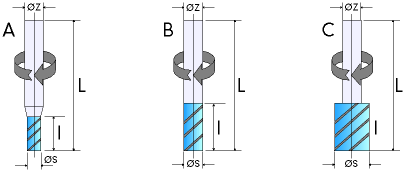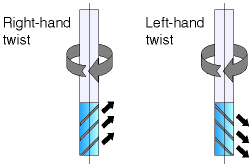 |
What You Should Know About Tools
|
|
Hints for the Right Choice of Carbide Tools
Reasons for few cutting edges ...
The main problem that may occur during the milling process is the possibility that chips may choke the tool. If a milling cutter is finally choked, it cannot carry out chips any more and the feeding force of the spindle will break it. This happens - depending on the material - in most cases long before the cutting edges are worn out. So the main question is where to put the chips. "To the to resp. to the back" is usually the answer (except left-hand twist cutters). However, a certain space is necessary to move the chips along the "body" of the cutter. A comparison of the cross section of different types shows clearly that the single tooth cutter offers the largest open space (size of the grove for chips) and that this space is reduced with increaing number of cutting edges. It is easier for a milling cutter with few cutting edges to dip into the material. For working on material which is used mainly for sign making like synthetic material, wood and non-iron metals, the single tooth cutter has certain advantages. The danger that the cutting edges may erode is not as serious as the problem that the cutter may get choked. Reasons for more cutting edges ...
The cutting edge is the working part of the tool. The more cutting edges a tool has, the more cutting edges share the tool erosion, thus the life of the tool is longer. A milling cutter which has two or more cutting edges runs more true than a milling cutter with just one cutting edge. Due to the larger cross section of the multiple teeth cutter, more heat is transported to the collet chuck. This is especially helpful if there is no other way of cooling. The more cutting edges there are, the smaller the chips become, so you will get smoother surfaces. A double tooth cutter is suitable especially for working on very hard synthetic material and harder alumium types. We recommend triple tooth cutters especially for very hard non-iron metals and iron workpieces.
|
|
Single tooth cutter

This tool offers a wider open space. |
Triple tooth cutter

Three cutting edges need much more space. |
|
Working Parameters
General rules:
- The higher you set the cutting speed (vc = pi * ØS * n), the smoother the surface will be. At the same time the erosion of the tool increases.
- Recommended cutting speeds vc for carbide milling cutters:
- Aluminium: 100 - 300 m/min
- other non-iron material (brass, bronze, copper, zinc): 100 - 200 m/min
- stainless steel (VA): 80 - 120 m/min
- thermoplastic: 50 - 150 m/min
- duroplastic with filling material: 100 - 150 m/min
carbon fiber compound material: 150 - 300 m/min
- Recommended feed fz per cutting edge and revolution for carbide milling cutters:
- Aluminium and other non-iron metals:
ØS 2 - 4 mm: 0.04 mm/rev, ØS 5 - 8 mm: 0.05 mm/rev, ØS 9 - 12 mm: 0.10 mm/rev
- thermoplastic:
ØS 2 - 4 mm: 0.05 mm/rev, ØS 5 - 8 mm: 0.06 mm/rev, ØS 9 - 12 mm: 0.07 mm/rev
- duroplastic:
ØS 2 - 4 mm: 0.04 mm/rev, ØS 5 - 8 mm: 0.08 mm/rev, ØS 9 - 12 mm: 0.10 mm/rev
- Formulas:
- revolution n: n [rev/min] = (vc [m/min] *1000) / (3.14 * ØS [mm])
- feed f: f [mm/min] = n * fz * z
Example: You want to mill aluminium with a double tooth cutter ØS = 3 mm (given above: max. vc = 200 m/min).
max. revolution n:
n = (200 * 1000) / (3.14 * 3) = 200.000 / 9.42 = 21230 rev/min
feed f:
f = 21230 * 0.04 * 2 = 1698 mm/min
|
|
Geometry and Dimensions of Milling Cutters

Shape A: diminished cutting diameter ØS < ØZ.
Shape B: cutting diameter equals staff diameter ØS = ØZ
Shape C: extended cutting diameter ØS > ØZ (only for drills)

Right-hand twist cutters:
The chips are transported to the top. The milling cutter tendends to lift up the workpiece (corkscrew effect).
Left-hand twist cutters:
The chips are pushed down, resp. moved to the back, i. e. to the already milled channel. The milling cutter pushes the workpiece down on the table (reversed corkscrew effect).
|
|

